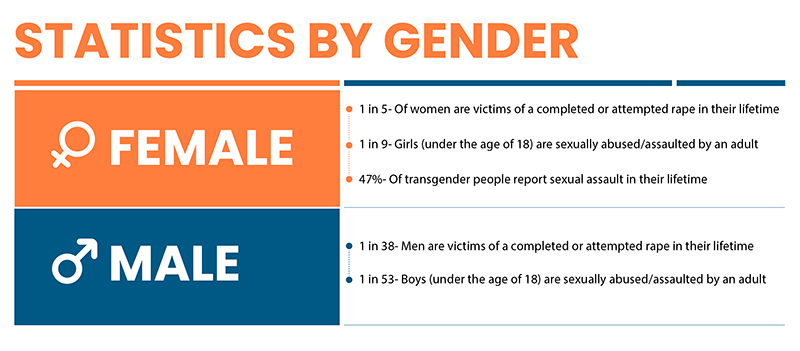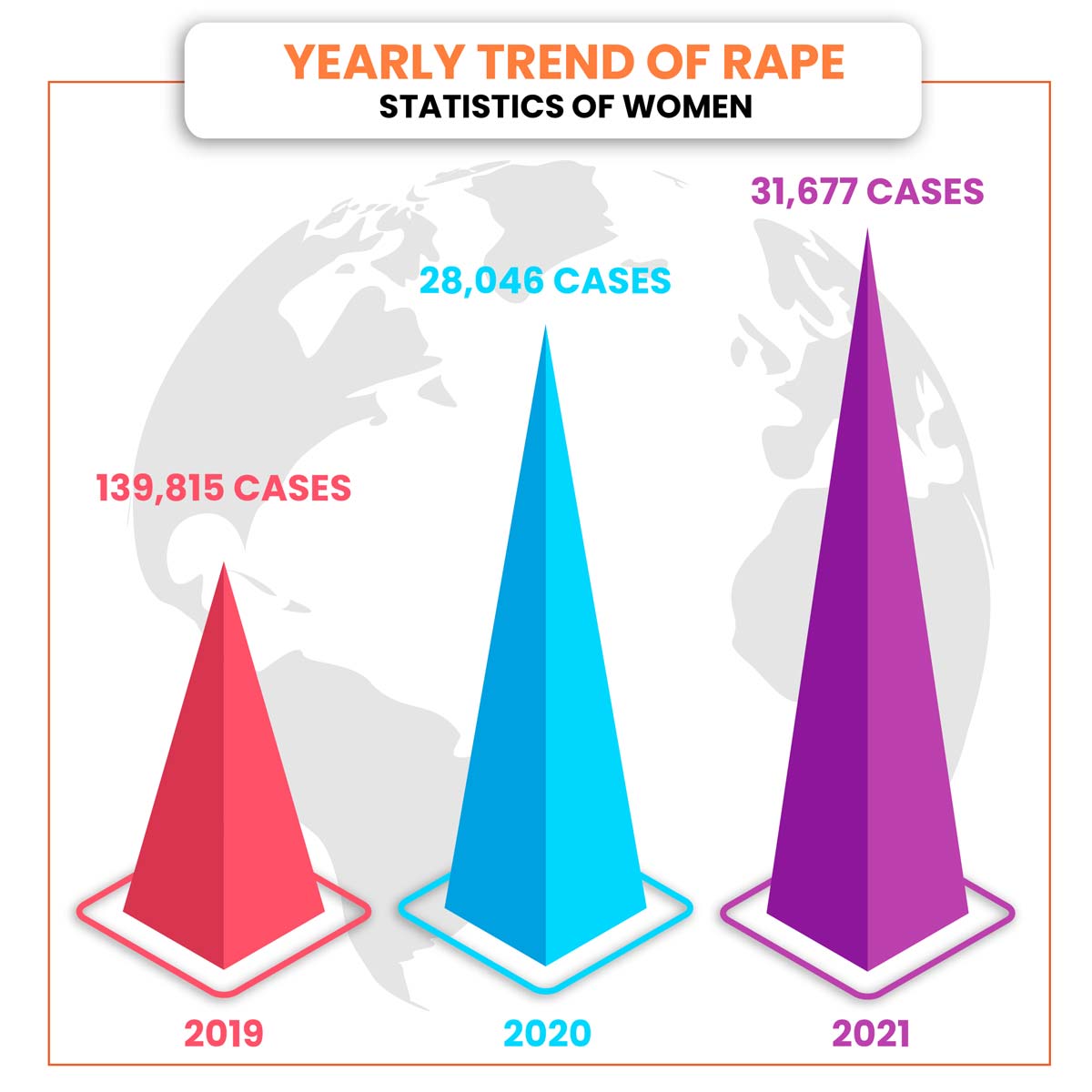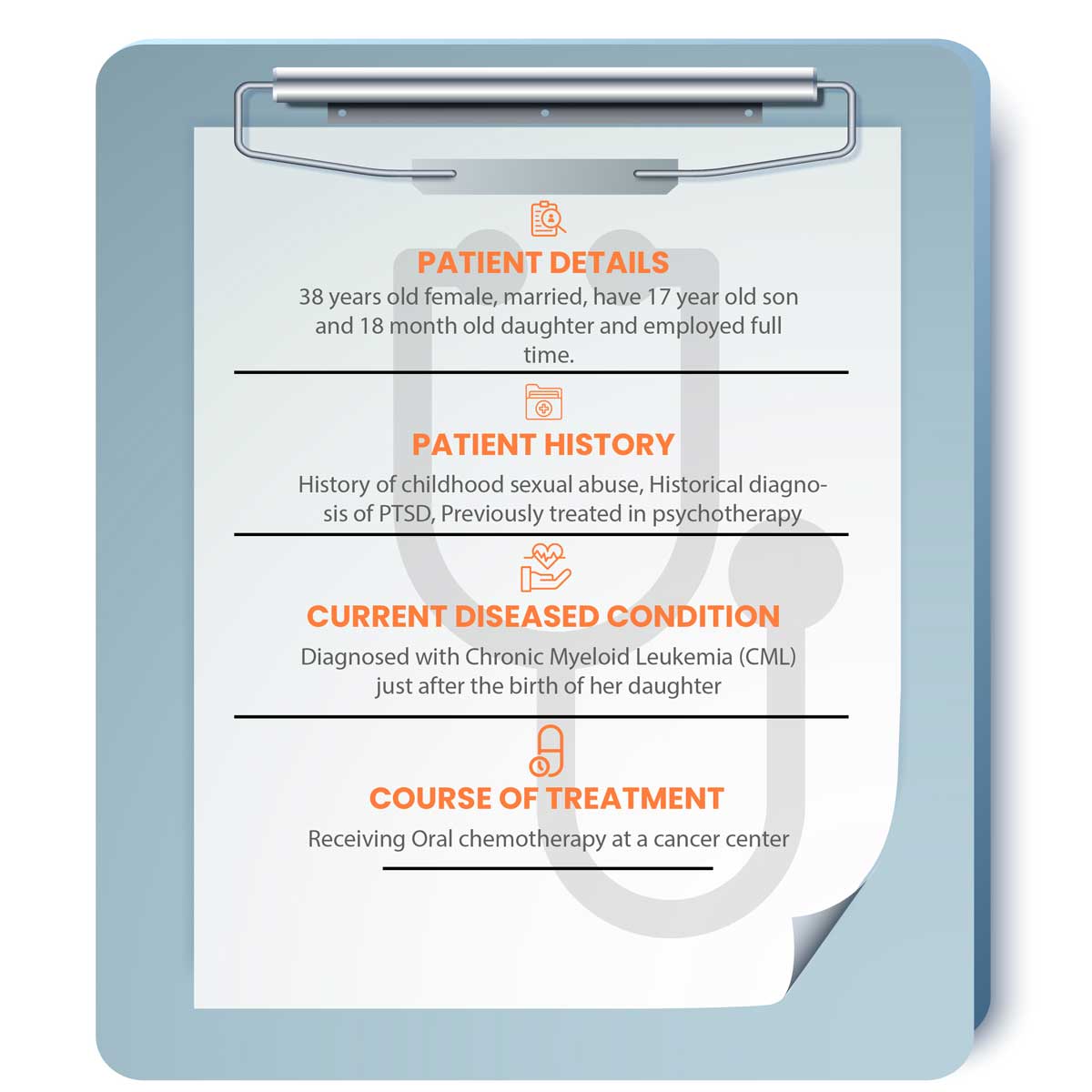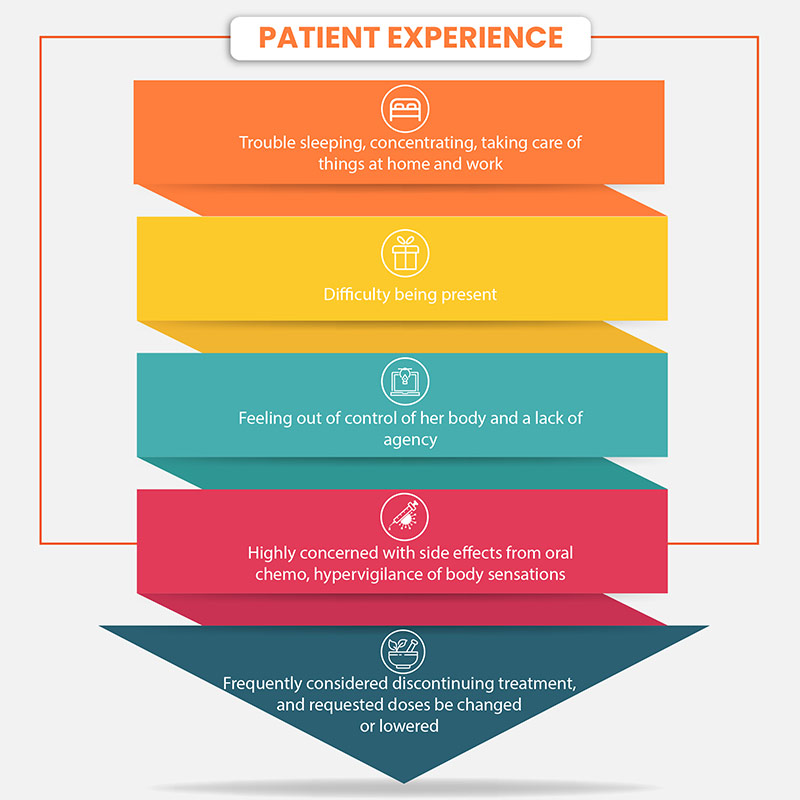Sexual trauma is increasing with the rising number of sexual assault. On average, one in five women and a quarter of men in the United States (U.S.) have experienced forceful sexual contact, which lead to damaging effects for a survivor. Children are the most commonly affected ones by sexual trauma. Around one in nine girls, and one in 53 boys under 18 will face sexual assault. Childhood sexual trauma is associated with multiple factors, such as posttraumatic stress disorder (PTSD), suicide, alcohol problems, depression, and eating disorders. These survivors may also experience very low sexual interest and multiple relationship difficulties and engage in high-risk sexual behaviors and extreme coping strategies. In most cases, women experience symptoms of a personality disorder, including one that is distinguished by enduring patterns of instability and impulsivity. Very much restricted data on risk factors recommends that family environment and supportive responses from family and close partners may improve mental health and function among survivors.
There are no wide-ranging statistics about the number of people having cancer who have a history of sexual trauma, but there is likely a huge overlap because of the high rates of both cancer and sexual assault in the United States.
- Causes
People who are experiencing sexual trauma suffer from enough stress and strain. In these situations, the body produces the stress hormone named cortisol. Post extreme violence, cortisol levels are increased in the body to hold off the shock. Increased amounts of this stress hormone protect against strenuous circumstances. But, this rate also increases the stress levels in the body. A person must be in a constant fight-or-flight response, even without any triggers. This may result in a condition called toxic stress.
- Symptoms
A person can have varied forms of symptoms, such as physical, psychological, or emotional. At times, there may be slight or no response to the violence that has taken place. In this regard, the body may choose to move on from the damage, but at other times, obvious signs refer to strong responses to violence.
Under the physical symptoms, a person feels hyperactive. The body is under constant fear, pressure and in this regard, the patient experiences headaches, sleeplessness, chest pain, stomach difficulties, or difficulty concentrating. Besides this, a person faces a great amount of psychological threats. A person faces sudden emotional outbursts, self-harm or tendency to commit suicide, difficulty concentrating, or any substance abuse. On emotional grounds, the person faces much trouble. Emotional numbing is common among these individuals; at times, intrusive thoughts that playback traumatizing scenes also create much disturbances.
- Effects
When a person goes through sexual trauma, he/she is bound to face many emotional, physical, and behavioral outcomes that take a heavy toll on these individuals. A survivor of assault may notice certain bodily changes post the trauma. Difficulties in the lower abdomen, chronic pain, and sleep difficulties are common consequences. Similarly, chronic fatigue, diabetes, eating disorders, and heart diseases, are all linked to the damage of sexual assault. Such sexual trauma can lead to severe emotional distress, such as they find difficult to trust any person or try to avoid physical contact with others. Fears to get involved with anyone emotionally. Sexual trauma poses a substantial concern and is related with heightened stress, negative health repercussions, and adverse economic effects. A history of abuse may increase a woman’s risk of developing cancer, especially cervical cancer.
Our DBMR team has investigated the global chronic fatigue syndrome market and witnessed that rise in the research and development activities in the market and rise in the demand from emerging economies will further create new opportunities for the chronic fatigue syndrome market in the forecast period. North America dominates the chronic fatigue syndrome market due to changing lifestyle and increasing healthcare expenditure rise in the availability of funds for research, huge patient population, increasing healthcare expenditures, well-developed healthcare sector and government support for research & development in this region.
To know more about the study, kindly visit: https://www.databridgemarketresearch.com/reports/global-chronic-fatigue-syndrome-market
If we consider this aspect, screening for sexual trauma in a gynecologic oncologic population is an appreciated opportunity to open up a history of abuse that may accelerate the chances of diagnosing a woman's cancer susceptibility. This study reveals that screening for sexual abuse in a gynecologic oncology setting may be integrated into new patient interviews with minimal disruption. Identifying an undisclosed sexual trauma history allows for an opportunity to provide counseling and reduce the emotional distress precipitated by treatment and exams.
Demography on Sexual Violence

Also, the National Crime Records Bureau (NCRB) records yearly trends of rape cases of women worldwide. It has been that in 2019, around 406,970 cases were recorded. The graphical representation of rape statistics from 2019-2021 is been shown below:

Impact of Sexual Trauma
Not one particular trait is common to all individuals with sexual trauma display. The impact trauma has on an individual can differ because of many factors, such as characteristics of an assault or trauma, characteristics of the survivor, available social support, and environmental factors.
Sexual trauma can be associated with different mental health disorders such as anxiety disorders, posttraumatic stress disorder, personality disorder, and depressive disorder.
People facing or suffering a minimum of four types of adverse childhood experiences, including childhood sexual assault, tends to have a high risk of cancer. It has been studied that there is a close relationship between childhood sexual abuse and many health conditions such as liver disease, headache, cancer, heart disease, gastrointestinal problems, and many others.
Our DBMR team has investigated the global anxiety disorder market and witnessed that North America dominates the market share due to increased investment by pharmaceutical industries for the advancement in the treatment and favorable reimbursement scenario. Asia-Pacific is expected to account for the largest market share over coming years for the Anxiety disorder market due to rapidly improving health care infrastructure in the region.
To know more about the study, kindly visit: https://www.databridgemarketresearch.com/reports/global-anxiety-disorder-market
Cancer as a Trigger
Cancer triggers negative thoughts and feelings associated with the sexual trauma, and can contribute to cumulative trauma. Many different types of tests can aggravate flashbacks of unwanted touch, feeling invaded and powerless, and may cause individuals to dissociate. Women suffering from cancer who experienced childhood abuse were more likely to have cancer-related intrusive thoughts, feelings, images and nightmares. There are three themes of triggers namely procedure related, provider related and emotion related.
The following procedures can serve as a trigger for people who have a history of sexual abuse:
- Darkness
- Infliction of pain by another
- Repeated exposure or penetration of sexual organs
- Being silenced and immobilized
- Immense vulnerability
In a study performed by Julie B. Schnur et.al on Cancer treatment experiences among survivors of childhood sexual abuse: A qualitative investigation of triggers and reactions to cumulative trauma, the list of procedures that participants found difficult or triggering was extensive, but among the participants, the most commonly mentioned difficult procedures were:
- Anesthesia – Participants were anxious by being touched, viewed, examined, and operated upon when they were unconscious, vulnerable, and unable to defend themselves
- Physical examinations – Participants were concerned about having their bodies inspected, penetrated, and commented on, especially on a radiologic examination.
- Undressing – Often, due to any wound or examination, the patient must be associated with feeling exposed, anxious, uncomfortable, and ashamed. This acts as a type of trigger in these traumatic patients.
- Multiple treatment Procedures- Patients being touched, particularly being touched in intimate areas of the body such as the upper thigh, face, lower back, buttocks, and genital/pelvic/“below the waist” areas. Treatments that combined multiple difficult procedures were seen as particularly distressing
Besides this, cancer can also lead to cumulative trauma. If we go by definition, cumulative trauma means exposure of multiple traumatic events across a lifespan. Trauma and PTSD symptoms are directly proportional, meaning that the more traumatic events that occur, the more severe PTSD symptoms one experiences.
Our DBMR team has investigated the global posttraumatic stress disorder (PTSD) market and witnessed that increasing sexual assault cases and rehabilitation programs for injured military personnel are also a driving factor for the market. North America is likely to lead the posttraumatic stress disorder (PTSD) market. The regional market has been driven by the rise in awareness of posttraumatic stress disorder. The market in Asia-Pacific is expected to exhibit a substantial growth rate during the forecast period due to rise in accident cases in this region.
To know more about the study, kindly visit: https://www.databridgemarketresearch.com/reports/global-post-traumatic-stress-disorder-market
Examples of Few Patients Associated With Procedure-Related Difficulties by Cancer Type
|
Type of Cancer
|
Patient Experience
|
Patient Description
|
|
Colorectal Cancer
|
“Every exam with an older male physician, I’ve been healing for a while and it brought it back.”
|
Male
|
|
Gynecologic Cancer
|
“I felt that my oncologist was treating me in the same manner as my abusers...as a piece of meat, and something to be conquered before they could move on and conquer the next person.”
|
Female
|
|
Breast Cancer
|
“The way people talk to you. The whole it’s going to be ok, trust me, I will take care of you. Those sayings really bothered me alot.”
|
Female
|
|
Skin Cancer
|
“great example is the skin procedures to remove layers of cancer, I was awake but my back was numb. I was half naked, numb and had a man in full control of my being - huge trigger.”
|
Female
|
|
Breast Cancer
|
“I absolutely do not like to be touched by males except for my spouse so anythime a male nurse would touch me, I understood he is just doing his job and hes not my permanent nurse but it triggered memories I did not like.”
|
Female
|
|
Skin Cancer
|
“Being ok with so many other people touching and commenting on my body, since I’ve avoided situations like that because of past abuse.”
|
Female
|
Considering provider-related trigger, the two most commonly mentioned provider characteristics were provider gender and unfamiliarity with the provider. Male providers, mostly older male providers, were seen as threatening for the patient, in the case when the abuser had been male. It was researched and found that participants feeling anxious and uncomfortable with male nurses, male radiation therapists, and male physicians; and on the other hand with regards to the unfamiliarity with the provider, providers who were new and who were seen as “strangers,” were found to be very much anxiety provoking to the patients.
On emotional state, patients having a history of childhood abuse had significantly increasing rates of depression, fatigue and stress before, during and after radiation than those who did not have history of childhood abuse. If distress is not understood properly, it can lead to immense delays in IV chemo or lower oral chemo medication adherence. If we go by the fact, it has been seen that people having history of sexual trauma have lower rates of cancer screening. Around 51% are less likely to be screened for prostate cancer. Then it has been seen that around 31% are less likely to have pap smear. 30% of people tend to less likely have a mammogram. Decreasing rates of screening can cause delayed detection of cancer, cancer being diagnosed at a later stage, declining treatment options.
Our DBMR team has investigated the global lung cancer screening software market and witnessed that North America region is expected to dominate the market and is the fastest-growing region owing to the factors such as increasing number of screening programs, growing adoption of software solutions for patient management, rise in the demand for screening with chest radiography and the presence of large number of screening centers. Also, increase in prevalence of lung cancer, rising awareness among people about lung cancer, increasing government initiatives and growing number of screening programs are some of the major factors driving the growth of the market.
To know more about the study, kindly visit: https://www.databridgemarketresearch.com/reports/global-lung-cancer-screening-software-market
Participants discussed having a feeling that their bodies were subject to forces out of their control that is cancer, having feelings of reduced agency, having lack of options or choices, and a sort of sense that they were vulnerable to and powerless before patients. These feelings of being vulnerable and defenseless strongly reminded patients of how powerless and vulnerable they felt during childhood sexual abuse. Secondly, several candidates reported elevated stress levels, and described cancer as the most difficult stressor since childhood sexual abuse, and that the stress itself induced memories of childhood sexual abuse. Next, the participants described struggling with uncertainty and fears of the unknown, not knowing what to expect, and thinking about what was to come, which also reminded them of their experience of abuse.
Examples of Few Patients Associated with Emotional triggers by cancer type
|
Type of Cancer
|
Patient Experience
|
Patient Description
|
|
Gynecologic Cancer
|
“The most difficult part of treatment was the feeling of not being in control, of being helpless in the face of something bigger and stronger than I was. I felt, once again, that I was powerless and that I wasn’t controlling my destiny, that the cancer was.”
|
Female
|
|
Colorectal Cancer
|
“Feeling like I was not in control. It reminded me of the experience of being molested as a child and not being in control of the situation.”
|
Male
|
|
Skin Cancer
|
“Feeling very vulnerable, and that I had no control over the sickness, it took me back to the vulnerable spot I was in when I was sexually abused.”
|
Male
|
|
Breast Cancer
|
“I think the most difficult part was trusting my body and my health to people I didn’t know and relying on them not to hurt me. I was going into a situation that I’d never been in before, and I had to depend on strangers to help me. I couldn’t even trust people close to me not to do me physical harm.”
|
Female
|
|
Colorectal Cancer
|
“The weakness. It sounds silly but I felt helpless just like when I did when it all happened.”
|
Female
|
|
Skin Cancer
|
“The only correlation I can make is that I once again felt like I couldn’t control myself/my body and that it was entirely up to someone else to be in charge of my fate.”.”
|
Male
|
Treatment Options for Sexual Trauma Patients
Going through a sexual trauma and have been able to undergo a proper treatment requires a lot of strength and exposure after all living with the trauma of sexual assault can be very hard to bear. This can leave an impact through every aspect of life, with respect to physical, emotional, mental, and social scars left behind. Although the effects of sexual violence can never be reduced, they can be properly coped with the right treatment. Here, is a short list of treatment options that can help the patients cope up with the situation.
- Cognitive-Behavioral Therapy
Cognitive-Behavioral Therapy (CBT) aims to diminish the negative thoughts and patterns that are found post trauma. This type of therapy is required to help withdraw the emotions and pain of sexual assault. This therapy helps the patients manage the different sets of emotions by building the positive energy in them and learning to counter the negative energy that comes in between.
Our DBMR team has investigated the global mild cognitive impairment (MCI) treatment market and witnessed that increase in the older patients population, ongoing research to find the perfect and effective cure is expected to drive the market's growth in the coming time. The U.S. is expected to dominate the mild cognitive impairment (mci) treatment market due to the ongoing research to find the perfect and effective cure. China is expected to dominate the Asia-Pacific mild cognitive impairment (mci) treatment market due to the growing geriatric population in the country.
To know more about the study, kindly visit: https://www.databridgemarketresearch.com/reports/global-mild-cognitive-impairment-mci-treatment-market
- Group Therapy
Therapy is always better when the victims find other survivors who have almost similar experiences with regards to that. The survivors of sexual assault may find a safe and assuring place to heal from their pain in group therapy. Speaking and listening to other survivors that have been through a similar experience, hearing their cope of mechanism, and comforting each other through the difficult times can offer a very crucial and important support system. Sharing experiences with each other can always help to manage the severity of trauma symptoms in survivors.
- Psychodynamic Therapy
Psychodynamic Therapy or psychoanalytic psychotherapy is a type of therapy that primarily focuses on the psychological roots of emotional suffering. Isolation, avoidance, numbing, and more such factors serve as emotional reminders of the pain of assault. This kind of therapy can assist to tackle the emotional conflicts that comes from traumatic incidents and can help to re-ignite self-esteem. This type of therapy teaches different systems of thinking and coping with trauma.
- Medication
Besides therapy, the last treatment option is medications. Pharmaceutical options like selective serotonin reuptake inhibitors are also highly recommended to manage severe trauma. These drugs are quite helpful to increase the serotonin level in the brain. Upgrading the serotonin level is important because this hormone impacts mood, sleep, and appetite. Selective serotonin reuptake inhibitors (SSRIs) are commonly used to manage depression, anxiety, and posttraumatic stress disorder (PTSD).
Trauma-Informed Care
Substance Abuse and Mental Health Services Administration (SAMHSA) has created a trauma informed framework for practice that is specific to behavioral health, but it can be adapted for other settings. This organization states it should involve policy and practice that nurtures feelings of trust, collaboration, safety, and empowerment amongst patients, addresses cultural, historical and gender-specific issues. There are several benefits associated with trauma-informed care such as it makes healthcare available to individuals with trauma and responding to their unique needs. The providers who received training on trauma-informed communication had their patient’s rate them higher on scale, measuring partnership/collaboration after the training occurred. It would be beneficial in oncology settings for individuals with history of sexual trauma. It addresses and reduces powerlessness, and prevents re-traumatization. To ensure that disclosing abuse helps improve care, healthcare providers must understand the impact trauma has, including traumatic stress and response, triggers, dissociation, somatization, and non-linearity of recovery process. For appropriate trauma-informed care, a trauma-informed setting should have an open, professional and sensitive atmosphere. Healthcare providers should avoid any sort of judgment or blaming, should have an abundance of time for disclosure and discussion. There should be routine screening for the patients, patients should consistently be offered a choice. Providers must collaborate with each other to ensure effective treatment. The patients can immediately connect to counseling or psychotherapy services, psychopharmacology by a psychiatric provider support groups, educational groups, peer support and many other supportive resources.
Case Study
The following case describes a patient diagnosed with chronic myeloid leukemia having a history of childhood sexual abuse.

Challenges Faced by Patient during the Treatment Course
- Freezing during appointments
- Feeling isolated
- Feeing invalidated, and that concerns or symptoms were minimized
- Attended appointments alone, lack of a support system
- Trouble speaking-stammering, difficulty finding words and asking questions
- Difficulty retaining information at appointments
- Feeling rushed through sessions
- Not properly informed about what to expect with symptoms or side effects

When she started her counseling sessions, she was told that she should not get pregnant due to the harmful effects of chemotherapy on a fetus. The patient had no intentions of becoming pregnant, but was sexually active and not on birth control. Medical team told her she needed to use a contraceptive which she refused. The team later told her that they would do a pregnancy test each time she came in. This act somehow angered and upset her, so she refused it. She later discovered that pregnancy tests were done without her knowledge with her bloodwork. The patient felt the intensified amount of feelings of anger, betrayal, being violated, powerlessness, and more.
Outcomes Post Treatment:
- The patient identified that her treatment team did not like her
- She also identified not liking members of the medical team
- She was identified as anxious and was prescribed benzodiazepines by oncologist, which she found minimally helpful
- Felt discouraged to contact them in between sessions with concerns
This case is a classic example of a patient experiencing sexual trauma having a condition of oncologic cancer.
Thus, if a proper patient relationship is maintained, it can help and make recovery faster. Appropriate measures must be taken while dealing with these sexual trauma patients as they are sensitive and exposure too many treatments and diagnosis due to cancer can accelerate their trauma.









